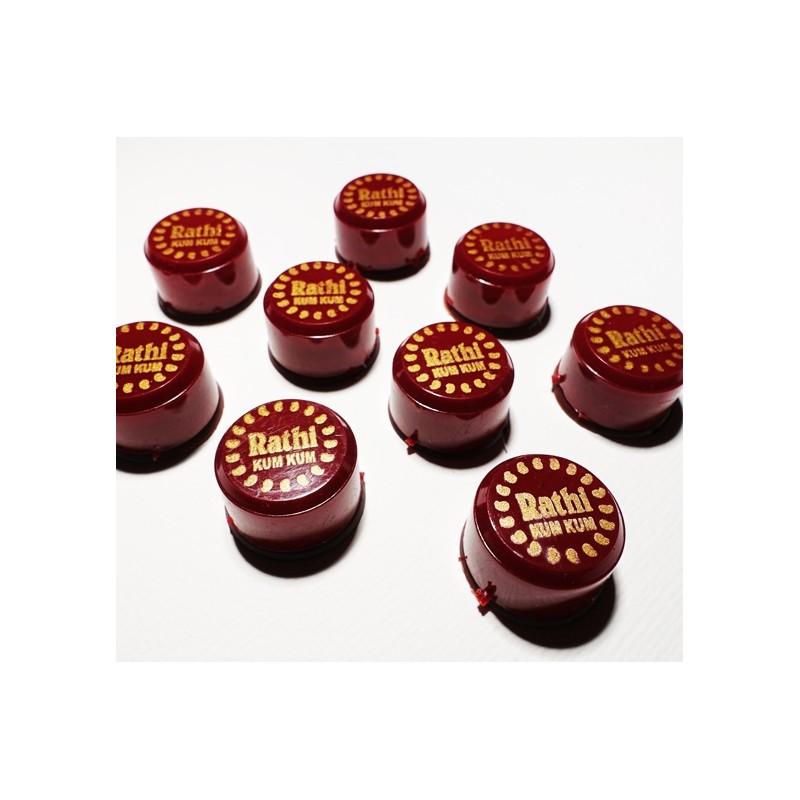- -0,90 €




Echtes Kumkum, hergestellt aus rotem Tumerik.
2g

Liefer- & Rückgabebedingungen

Datenschutz
Historische Bedeutung des Kumkum:
Tradition of applying Kumkum is said to be 5000 years old. Instance of the practice of placing kumkum is mentioned in ancient texts like the Puranas, Lalitha Sahasranamam, Soundarya Lahhari etc. Besides, it has been told that Radha turned the kumkum into a flame- like design on her forehead. Draupadi, in despair and disillusion, wiped the kumkum off her forehead on that dark day at Hastinapur.
How is Kumkum Different from Sindoor?
Kumkum and sindoor are prepared from two different materials. While Kumkum is made of red turmeric, Sindoor, which is worn on the centre parting of the hair, is made of zinc oxide.
In Indian culture, both sindoor and kumkum are auspicious. Both stand for good fortune and signs of "Soubhagya" in the case of a married woman. Therefore, women who had lost their husbands did not wear kumkum. Many married women would use turmeric as a substitute merely to indicate, not widowhood, but a state of mourning in the family. In some communities, womenfolk refrained from wearing kumkum during menstruation.
Today, most men wear kumkum specifically during worship or religious ceremonies.
Pure kumkum is prepared from haldi itself. Pure haldi powder is mixed with decanted solution of lime (chuna) and little pure camphor and we get pure kumkum. We can identify haldi by its fragrance but once kumkum is ready haldi loses its fragrance completely. A new divine fragrance is developed in the kumkum and it then spreads all over for a certain distance. Here it would be useful for us to know about identification of pure kumkum.
The pure kumkum appears dry in spite of containing moisture and its touch is ice cold. In subtle dimension:
The divine energy present in the kumkum is activated and emitted.
This energy then moves in all directions in circular fashion.
Simultaneously the chaitanya or the inner knowledge present in the kumkum is also emitted.
Thus the kumkum has a special spiritual significance because of its property of constant emission of divine energy and divine consciousness. As it is prepared from haldi it contains large proportion of earth frequencies just as in haldi. Because of its red colour it has more capacity to attract Durga devi principle. The divine energy present in the kumkum purifies the vital air body and mental body of the worshipper. The negative energies cannot enter in the worshipper because of its application on the midbrow. In the ritualistic worship of Devi (Divine enrgy) use of haldi and kumkum have special importance. The kumkum is offered to Devi while chanting her mantra or thousand names. This is known as Kumkumarchan.
The dot or bindi also known as 'tika', 'pottu', 'sindoor', 'tilak', 'tilakam', 'bindiya', 'kumkum' and by other names. Pronounced as 'Bin Dee', the word bindi is derived from the Sanskrit word bindu, which means "drop". Bindi is an auspicious ornamental mark worn by Hindu girls and women on their forehead between the two eyes . Bindi is arguably the most visually fascinating in all form of body decoration. More than a beauty spot, the manga tika (bindi) indicates good omen and purity.
Traditionally Bindi is a symbol of marriage, very similar to western wedding bands. A red dot on the forehead is an auspicious sign of marriage and guarantees the social status and sanctity of the institution of marriage. Bindi were worn by married women in North India in the form of a little red dot. It denotes the woman's married status in most of the North Indian communities but in South India it is a prerogative of all girls to wear a bindi. The bridegroom's make-up is incomplete without Tilak, it is applied on the groom's forehead during the wedding ceremony. No festival or puja is complete without the tilak and sindoor. Red was chosen because that
color was suppose to bring good fortune into the home of the bride. The red mark made the bride the preserver of the family's honor and welfare. Over time, it has became a fashion accessory and is worn today by unmarried girls and women of other religions as well. No longer restricted in color or shape, bindis today are seen in many colors and designs and are manufactured with self-adhesives and felt.
The very positioning of the bindi is significant. The bindi is always worn on in the middle of the eyebrows, this is believed to be the most important pressure point of the human body. This point is known by various names such as Ajna chakra, Spiritual eye, Third eye meaning 'command', is the seat of concealed wisdom. It is the centre point wherein all experience is gathered in total concentration. According to the tantric cult, when during meditation the latent energy rises from the base of the spine towards the head, this 'agna' is the probable outlet for this potent energy. The red 'kumkum' between the eyebrows is said to retain energy in the human body and control the various levels of concentration. It is also the central point of the base of the creation itself 97 symbolising auspiciousness and good fortune.
No one knows exactly when the tradition of putting a bindi started, but since centuries it is seen on the foreheads of Hindu men and women. In the past few decades, not only married women have taken up this
beautiful accessory. Girls of all ages enjoy wearing a variety of styles and colors. Today, the bindi is more about the mood and occasionThey are often matched with the color clothing a person is wearing. Today, bindi is more of a fashion statement than anything else, and the number of young performers sporting bindis is overwhelming even in the West.